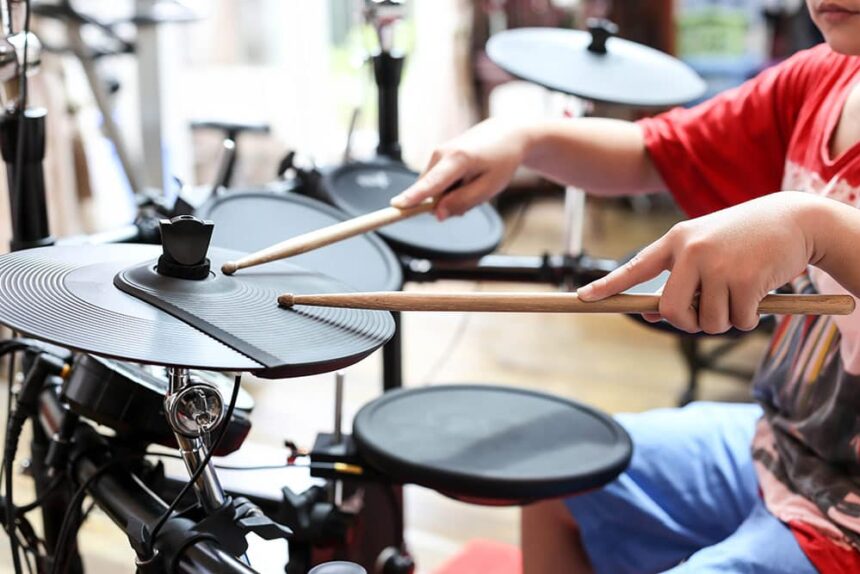Starting something new can be both exciting and a little nerve-wracking, especially when it comes to learning a musical instrument like the drums. Whether you’re a complete beginner or have some musical experience, your first drumming class is an important step in your journey as a drummer.
Understanding what to expect can help ease any anxiety and allow you to fully enjoy the experience. This article will guide you through what you should expect in your first drumming class, from the basics of equipment and technique to the structure of the lesson and what you’ll take away from it.
1. Introduction to the Drum Kit
Understanding the Components
- Drum Set Overview: One of the first things you’ll do in your initial African Drumming class is familiarize yourself with the drum kit. Your instructor will likely give you a brief tour of the different components of the drum set, including the bass drum, snare drum, toms, hi-hat, and cymbals. Each part of the drum kit serves a specific purpose, and understanding these functions is crucial as you begin learning.
- Setting Up the Kit: You’ll also learn how to properly set up the drum kit, including adjusting the height and position of the drums and cymbals to suit your body size and playing style. Proper setup is essential for comfortable and effective drumming, so pay close attention to your instructor’s guidance.
Basic Drum Terminology
- Common Terms: During your first class, you’ll be introduced to basic drum terminology. This might include terms like “kick,” “fill,” “groove,” “rudiments,” and “stick grip.” Understanding these terms will help you communicate with your instructor and follow along with future lessons more easily.
2. Learning the Basics of Drumming Technique
Proper Posture and Grip
- Posture: One of the first things your instructor will emphasize is the importance of proper posture. Sitting correctly at the drum kit is essential for both comfort and technique. Your instructor will guide you on how to sit with a straight back, relaxed shoulders, and feet flat on the pedals.
- Stick Grip: How you hold your drumsticks is crucial to your drumming success. Your instructor will likely show you the correct way to grip the sticks using either the matched grip or traditional grip, depending on the style of music you’re interested in. They’ll also demonstrate how to strike the drums and cymbals with the right amount of force and control.
Basic Rhythms and Patterns
- Simple Beats: After covering the basics of posture and grip, you’ll likely start learning some simple rhythms. Don’t worry if it feels challenging at first—your instructor will guide you through basic patterns, such as quarter notes and eighth notes, to help you get comfortable with keeping time.
- Coordination Exercises: Drumming requires coordinating both hands and feet, which can be tricky for beginners. Your instructor might introduce exercises that focus on developing this coordination, helping you play different rhythms with your hands and feet simultaneously.
3. Introduction to Reading Drum Notation
Understanding Drum Sheet Music
- Basic Notation: If your drumming lessons include reading music, your first class may involve a brief introduction to drum notation. Drum sheet music is different from traditional sheet music, with symbols representing different parts of the drum kit. Learning to read these symbols will allow you to follow along with exercises and songs in future lessons.
- Simple Exercises: Your instructor might introduce you to some simple exercises or patterns written in drum notation. These exercises will help you get used to reading and playing at the same time, which is an essential skill for any drummer.
4. Getting to Know Your Instructor and the Class Structure
Instructor’s Teaching Style
- Personalized Approach: Every drum instructor has a unique teaching style, and your first class is an opportunity to get to know them and how they structure their lessons. Some instructors may focus heavily on technique and drills, while others might incorporate more creative exercises or focus on playing along with music.
- Open Communication: Don’t hesitate to ask questions or express any concerns you may have during your first lesson. Your instructor is there to help you, and open communication will ensure that the lessons are tailored to your learning style and goals.
Lesson Structure
- Warm-Ups and Drills: Many drumming lessons begin with warm-up exercises or rudiments, which are fundamental drumming patterns that help develop speed, endurance, and control. Expect to spend a few minutes on these exercises at the beginning of each class.
- Playing Music: Depending on your level and the instructor’s approach, you might spend some time playing along with a song or a backing track. This is a fun way to apply what you’ve learned and start developing your musicality.
- Homework and Practice: At the end of your first class, your instructor will likely give you some exercises or rhythms to practice at home. Regular practice is key to improving your drumming skills, so be sure to dedicate time to it between lessons.
5. What You’ll Take Away from Your First Class
A Sense of Accomplishment
- Small Wins: Even if you only learn a few basic rhythms or how to hold the sticks properly, your first drumming class will leave you with a sense of accomplishment. Every small step forward is progress, and mastering the basics is essential for more advanced drumming.
- Motivation to Learn: Your first class should leave you feeling motivated and excited to continue learning. Drumming is a skill that takes time and dedication to develop, but the journey is incredibly rewarding.
Practical Knowledge
- Foundational Skills: You’ll leave your first class with some foundational drumming skills, such as proper posture, stick grip, and basic rhythms. These skills are the building blocks for everything you’ll learn in the future.
- Understanding of What’s Ahead: Your first lesson will also give you a clearer idea of what to expect in future classes. Whether it’s learning more complex rhythms, improving your coordination, or playing along with songs, you’ll have a better sense of the drumming journey ahead.
Enroll in Drumming Class
Your first drumming class is an exciting step into the world of rhythm and music. It’s a chance to learn the basics, get to know your instructor, and start developing the skills that will make you a confident and capable drummer. While there might be challenges along the way, remember that every great drummer started with the basics, just like you. With practice, dedication, and the right guidance, you’ll be well on your way to mastering the drums and enjoying all the benefits that come with it. So, grab your sticks, sit down at the kit, and get ready to make some noise!




